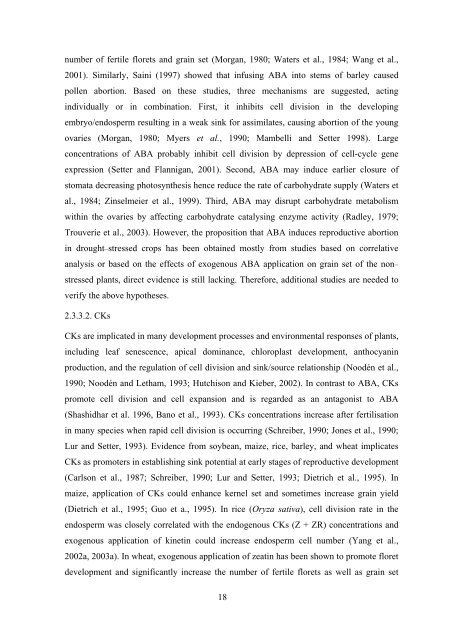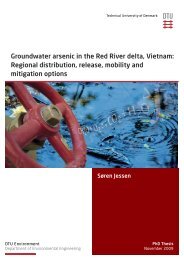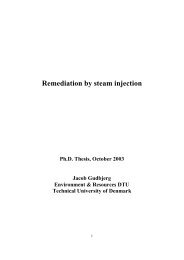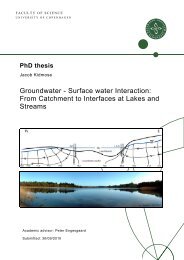Download PhD Thesis - Fiva
Download PhD Thesis - Fiva
Download PhD Thesis - Fiva
Create successful ePaper yourself
Turn your PDF publications into a flip-book with our unique Google optimized e-Paper software.
number of fertile florets and grain set (Morgan, 1980; Waters et al., 1984; Wang et al.,<br />
2001). Similarly, Saini (1997) showed that infusing ABA into stems of barley caused<br />
pollen abortion. Based on these studies, three mechanisms are suggested, acting<br />
individually or in combination. First, it inhibits cell division in the developing<br />
embryo/endosperm resulting in a weak sink for assimilates, causing abortion of the young<br />
ovaries (Morgan, 1980; Myers et al., 1990; Mambelli and Setter 1998). Large<br />
concentrations of ABA probably inhibit cell division by depression of cell-cycle gene<br />
expression (Setter and Flannigan, 2001). Second, ABA may induce earlier closure of<br />
stomata decreasing photosynthesis hence reduce the rate of carbohydrate supply (Waters et<br />
al., 1984; Zinselmeier et al., 1999). Third, ABA may disrupt carbohydrate metabolism<br />
within the ovaries by affecting carbohydrate catalysing enzyme activity (Radley, 1979;<br />
Trouverie et al., 2003). However, the proposition that ABA induces reproductive abortion<br />
in drought–stressed crops has been obtained mostly from studies based on correlative<br />
analysis or based on the effects of exogenous ABA application on grain set of the non–<br />
stressed plants, direct evidence is still lacking. Therefore, additional studies are needed to<br />
verify the above hypotheses.<br />
2.3.3.2. CKs<br />
CKs are implicated in many development processes and environmental responses of plants,<br />
including leaf senescence, apical dominance, chloroplast development, anthocyanin<br />
production, and the regulation of cell division and sink/source relationship (Noodén et al.,<br />
1990; Noodén and Letham, 1993; Hutchison and Kieber, 2002). In contrast to ABA, CKs<br />
promote cell division and cell expansion and is regarded as an antagonist to ABA<br />
(Shashidhar et al. 1996, Bano et al., 1993). CKs concentrations increase after fertilisation<br />
in many species when rapid cell division is occurring (Schreiber, 1990; Jones et al., 1990;<br />
Lur and Setter, 1993). Evidence from soybean, maize, rice, barley, and wheat implicates<br />
CKs as promoters in establishing sink potential at early stages of reproductive development<br />
(Carlson et al., 1987; Schreiber, 1990; Lur and Setter, 1993; Dietrich et al., 1995). In<br />
maize, application of CKs could enhance kernel set and sometimes increase grain yield<br />
(Dietrich et al., 1995; Guo et a., 1995). In rice (Oryza sativa), cell division rate in the<br />
endosperm was closely correlated with the endogenous CKs (Z + ZR) concentrations and<br />
exogenous application of kinetin could increase endosperm cell number (Yang et al.,<br />
2002a, 2003a). In wheat, exogenous application of zeatin has been shown to promote floret<br />
development and significantly increase the number of fertile florets as well as grain set<br />
18





